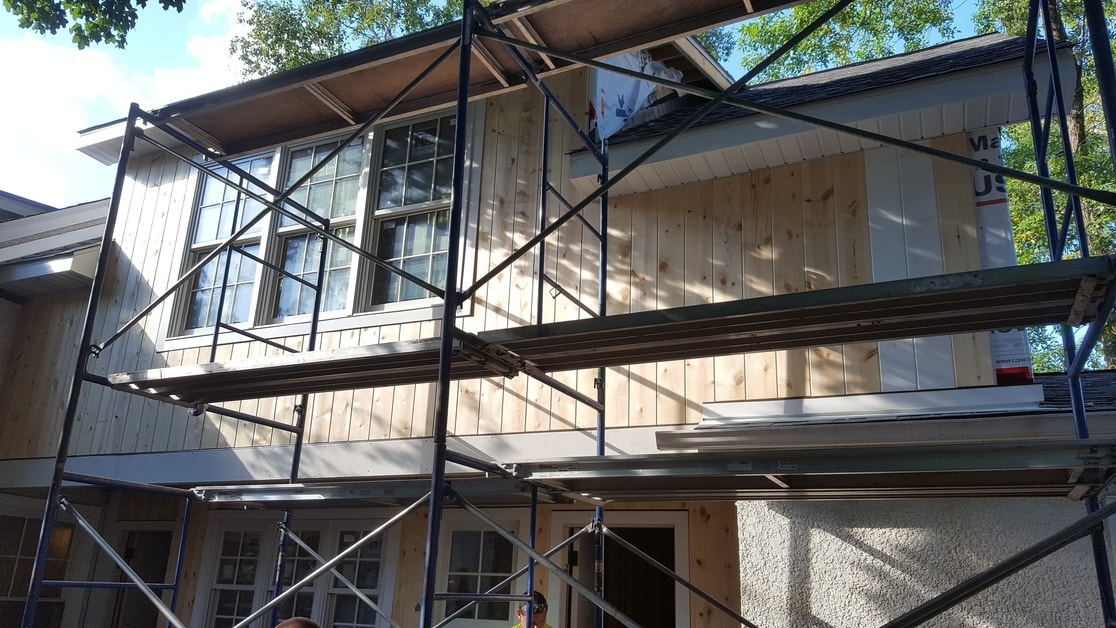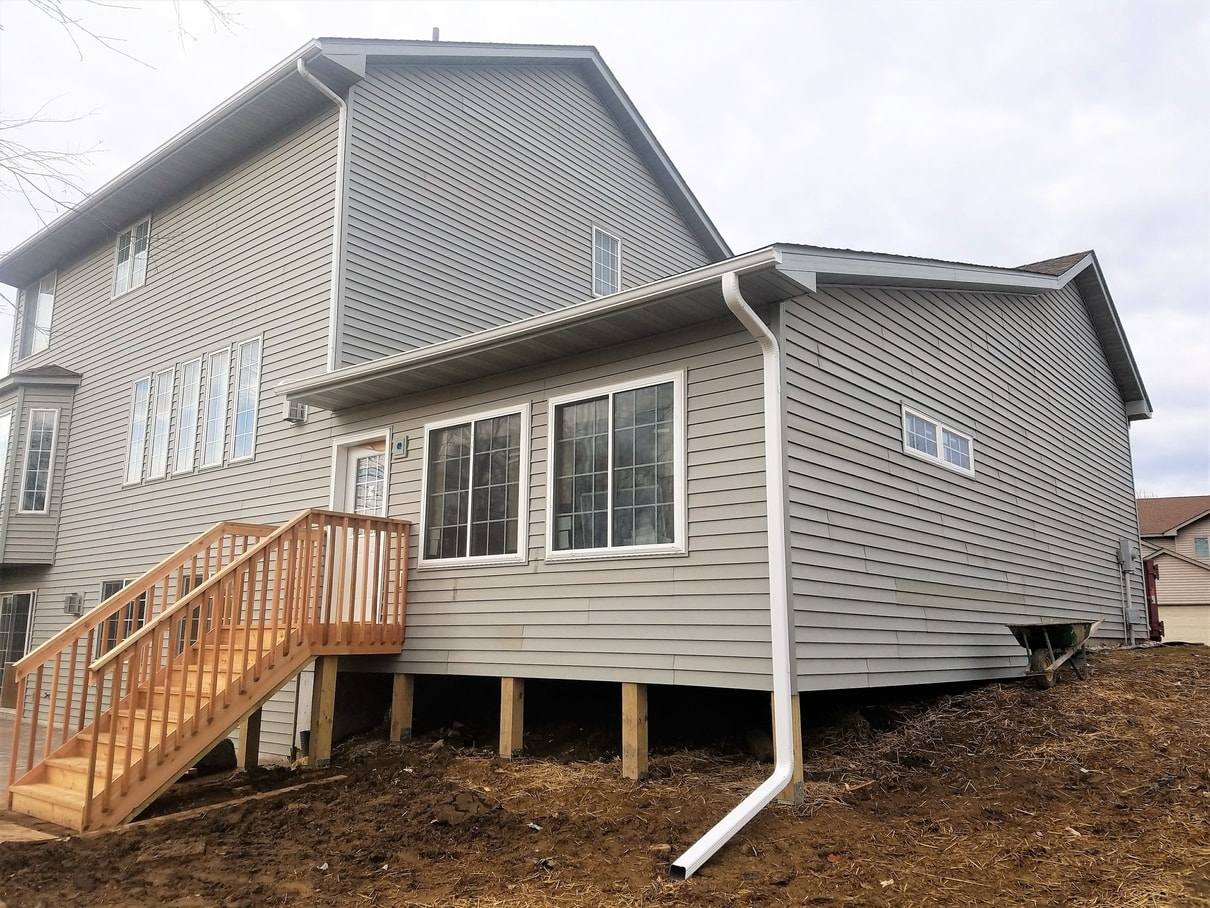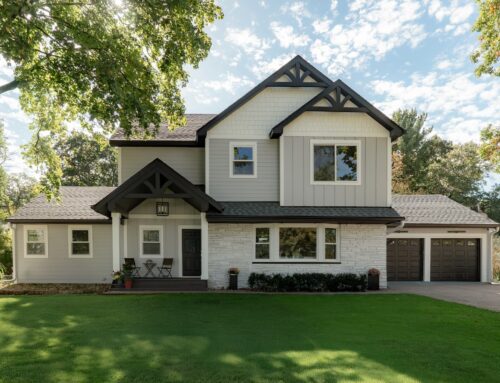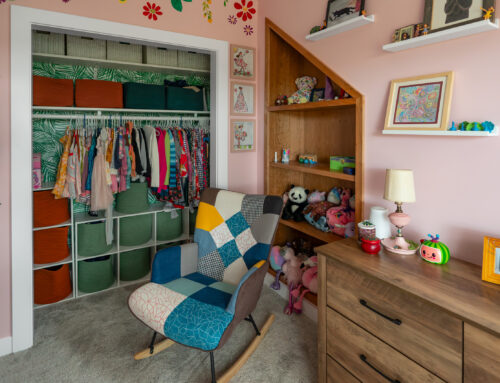It’s no secret that home exterior upgrades can be costly. But putting them off, especially in a harsh climate like Minnesota, can lead to way bigger (and more expensive!) problems down the line. So lace up your shoes, take a little stroll around your house, and see if you spot any of these common home exterior issues.
Damaged or Dated Siding
Siding and masonry are your home’s first line of defense against the elements. When in good repair, your home’s exterior keeps warm air indoors while keeping cold air, moisture, and unwelcome critters out.
But, no siding lasts forever. And it’s especially prone to damage after a Minnesota summer filled with storms and high winds. Not only that, but older model vinyl siding often has a short lifespan and its insulating properties fall short of upgraded materials.
“Many homeowners are starting to invest in siding upgrades, opting for Hardie and LP Smart Siding instead of vinyl. Not only is it great for curb appeal, but it’s low-maintenance and up to 5x thicker than traditional vinyl. This offers superior durability and resistance to sun, sleet, hail, and fading from UV rays,” explains Scott Herrmann, the exterior division manager at Titus Contracting in Burnsville, MN.
But how can you tell if your siding needs repair? Look around for these common signs your siding is damaged:
- Loose boards — Strong winds can loosen boards — or pull them free entirely! An experienced contractor can help you determine whether you can repair a few boards or if it’s time to replace your siding altogether.
- Faded color or peeling paint — While fading over time is often a simple cosmetic issue, if your home needs frequent painting to combat peeling, there might be more going on. Search for signs of rot, including bubbling and peeling paint, gaps between boards, or insects like carpenter ants.
- Visible warping or bowing — As wood rots, the cellulose breaks down, causing shrinkage, warping, and bowing over time. If a board looks funny, give it a few taps with the handle of a screwdriver. If it sounds hollow, or crumbles or splits, that’s a sign your siding has rotted.
- Holes, splits, or cracks — Any compromises in your siding’s integrity give moisture and insects a chance to creep in. Seal any small cracks with caulk and schedule an inspection if you suspect a larger issue.
- Fungus, mold, or mildew — Some mold or mildew on siding is normal, especially in shaded spots that don’t get much airflow. Still, be sure to clean it twice a year to prevent damage. Also, keep your eye out for fungus or a gray cottony texture on the siding, which can indicate a bigger problem.
Not only does quality siding boost your home’s curb appeal and resale value, but it protects the structural integrity and overall health of your home. Ensure your home is clean, safe, and critter-free by keeping your siding in tip-top shape.
 A Dated, Damaged Roof
A Dated, Damaged Roof
Remember when you were little and your mom made sure you had a hat on before you ran outside in the snow? She knew what she was talking about. Heat rises, so keeping on a tight lid to lock in the heat helps you stay cozy, even on the coldest winter days.
The same is true for your home’s roof. Not only does a solid roof keep out unwanted elements like rain and snow, but it keeps warm air trapped inside.
So how can you tell if your roof needs replacing? Grab a ladder — or call an inspector — to look for these common signs of roof damage.
- Interior water damage — The most obvious signs of exterior damage might show up on the inside. Look for staining and discoloration along the ceilings and walls in your home. It’s often a sign of water damage, which might indicate a leak somewhere in your roof.
- Shingles that don’t lie flat — When shingles curl up around the edges, that’s an issue. Age or damage from ice dams or high winds can cause shingles to curl along the edges, which compromises the integrity of your roof. It’s important to replace damaged sections to keep your home warm and dry.
- Missing or torn shingles — Likewise, missing shingles are a liability. Be sure to repair or replace your roof ASAP if you notice missing or torn shingles.
- Soffit and facia damage — The soffit and facia (the horizontal and vertical boards you can see where your roof overhangs your home) are good spots to look for signs of a leaky roof. If you see warping, splitting, or rot along the soffit or fascia it might be caused by a roof leak or issues with gutter drainage.
- Check the gutters — Hail can damage the shingles’ surface, causing asphalt granules to detach and run off into the gutters. Without their granular coating, shingles aren’t fully equipped to keep out the elements, so it’s important to address shingle damage before winter. If you suspect roof issues, schedule an inspection now before the snow falls. Some problems can be fixed with a small-scale repair. Prevent ice dams and extensive interior damage and save yourself thousands in costly repairs come springtime.
Drafty Doors and Windows
Sitting by a roaring fire, sipping freshly brewed hot coffee, and watching the snowfall. That’s a pretty dreamy winter day. But if your home’s windows are drafty or rotted, wintertime can be more like a long, cold nightmare.
But are they just dated, or is the damage more extensive? Here are 5 signs your windows need to be replaced:
- Noticeable drafts — A drafty window or door is rarely a secret. You can actually feel — sometimes even see — cold air blowing in from outside. Not only is this uncomfortable, but it makes your furnace work overtime and costs you extra cash with each heating bill.
- Single pane style — While not technically damage, if your home still has single pane windows, you’re losing energy and money every single day. Upgrade to a double or triple glazed model for added efficiency and comfort this winter.
- Condensation — If the glass gets dewy and wet, or frosted over when temps really get low, that might be a sign your windows need to be replaced. And if that moisture is trapped between the window panes? That means the airtight seal has been broken and requires replacement as soon as possible.
- Decaying frames and rot — Even high-quality wood-framed windows don’t last forever. If your windows have crumbling or other signs of rot around the frames and sills, it’s probably time to get them replaced.
- Visible damage — Cracks in the glass. Rotting wood around the exterior. Or windows that don’t open and close properly. If your windows aren’t sealing in the heat — or giving you easy access to summer breezes when the weather is nice — it’s worth looking into an upgrade.
Being a homeowner brings responsibility. But maintaining the exterior of your home doesn’t have to feel overwhelming. With a trusted contractor on your side, you can identify and address any potential issues quickly and get your Minnesota home ready for whatever winter brings.










